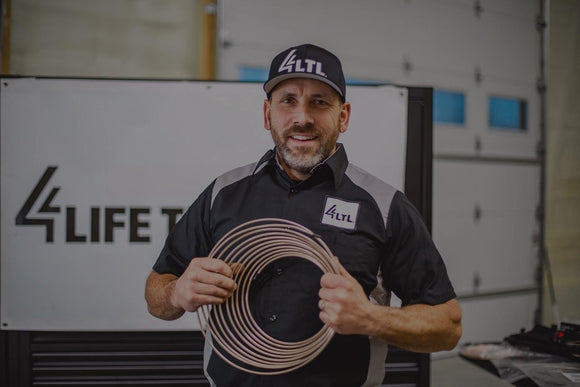
Tight Quarters: Routing Brake Lines

If we examine how a vehicle is built, we find that the brake lines are installed very early on in the assembly process. Components such as wiring harnesses and brake lines get attached to the bare frame, chassis, suspension, and underbody long before the engine, transmission, fuel tank, and differentials are installed. They're hard-baked into the structure of a car by design, and that makes servicing tough. Technicians often quip that the engineers designing passenger vehicles don’t even think about the servicing aspect when they draw up the plans.
You're familiar with brake lines if you're on 4Lifetimelines' website, so you know that even if you take the best care of your vehicle, brake lines don’t last forever. Factories mass-produce their vehicles with steel lines to cut down on manufacturing costs, and while it's practical from the manufacturer's perspective, it also means that the average vehicle owner is going to get bit: those steel lines are going to rust out someday, especially in the “rust belt” northern states. Road salt and brine make sure of that. It's not a question of whether or not you will need to replace your brake lines, it's a question of when… but replacing brake lines isn't easy.
It takes a lot of work to access the hydraulics. Brake lines typically sneak their way around and between multiple systems throughout the whole car: from the brake master cylinder down along the firewall, along the suspension, and over to the anti-lock brake modulator, then on to the proportioning valve and the rear wheels. In an ideal world the lines would be easy access to, but unfortunately being hard-baked into the vehicle means that you have to confront the idea of getting into the engine compartment, and that presents a host of challenges. Two of the major ones are navigating a brake line around the steep angle of the firewalls and clearing the way to the brake lines through the rest of the vehicle's parts and systems. The steep angle of the firewall makes installing your average steel lines challenging because steel isn't flexible enough to be maneuvered through the complicated apparatus of the engine without bending out of shape or kinking. This necessitates raising the car to access the brake system from below, replacing the lines with more gently bending curves and straights. Even then, sometimes it's even necessary to remove engine-related obstructions such as the airbox, exhaust, steering rack, and other fiddly assemblies to gain enough clearance to install the lines properly.
Fortunately, steel isn't the only brake line material out there. If you're looking for more information 4LifetimeLines has a Brake Line Breakdown Knowledge Garage installment about the different brake line materials available. Many savvy technicians and DIY mechanics have discovered that using modern copper-nickel tubing for their brake lines solves all their problems. That's not a marketing bit: all of the problems outlined above can be easily resolved with just a simple change in the metal's composition. Copper-nickel alloy simply does not rust, and where great care must be taken to avoid bending and kinking steel brake lines, Copper-nickel brake line tubing bends easily by hand and can be worked around obstructions like the firewall to save large amounts of time. Further, good quality Copper-nickel tubing is annealed and can be manipulated without fear of work-hardening the material, whereas bending the same spot multiple times with a steel line fractures its molecular structure, making the tubing in that area prone to snap or kink.
Working with steel brake tubing along the suspension components and in the wheel well can also prove more difficult than necessary. Most factory tubing is shipped to the assembly line pre-bent in order to hug the suspension perfectly every time a car is assembled. Factories can pull that off with a larger infrastructure of jigs and benders, but when all you've got is a shop space and hand tools it's difficult to get those precise "hugging" bends around the contours of the vehicle. Also, the ends of the steel tubing must be oriented very precisely in order for the tube nut threads to engage. Again, Copper-nickel brake tubing comes in handy here, and while it still must be precisely formed to match the factory brake line shape, the process is much easier because the bends and alignment can be done by hand: quickly, and often without any bending tools.
Arguably the most challenging area to form replacement brake lines around is the fuel tank, where crossover rear brake lines are frequently routed. With a space so tight, installing a steel brake line usually entails removing the whole tank, but if you've got a more flexible material, like Copper-nickel tubing, you can carefully push your replacement brake lines into position over the tank. Just make sure to tape your tubing ends off before working, and then remove the tape when you wrap up the assembly.
If it isn't obvious by now, I recommend you make the leap to Copper-nickel tubing the next time you find yourself needing to replace your brake lines. When handled right it will never rust, kink, or distort, and it's flexible to boot, so obstructions like the crowdedness of the engine compartment are no problem. It's even available here on the 4Lifetimelines website for one of the most affordable prices around. If you're convinced by nothing else, be convinced by this: 4LTL is proud to serve as one of the automotive aftermarket fastest-growing, highest-quality providers, and we back that claim with a Lifetime Warranty on all of our products. We like our customers. They get stuff done.
Did you enjoy reading our blog? If so, let us know by using promo code: BLOG10 at checkout and get 10% off of your order!
Best of luck on your next brake replacement project,
The 4LTL Team

